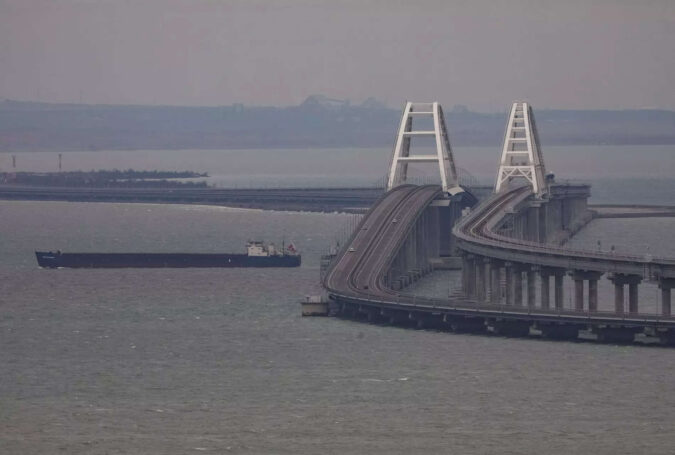Traffic on the road-and-rail bridge linking Russia and the Crimean peninsula was stopped early on Monday due to an “emergency situation,” the Russian-backed head of Crimea’s administration, Sergei Aksyonov said.
The RBC-Ukraine news agency reported that explosions were heard on the bridge, with Russian military bloggers reporting two strikes. The bridge is a crucial supply route for Russian forces in Ukraine.
Reuters was not able to independently verify the reports. There was no immediate comment from Ukraine.
In October, the bridge was damaged in a powerful blast, with Russian officials saying the explosion was caused by a truck that blew up while crossing the bridge, killing three people.
President Vladimir Putin has branded the October blast a “terrorist attack” orchestrated by Ukrainian security services and ordered a wave of retaliatory strikes on Ukrainian cities including the capital Kyiv afterwards.
Ukraine’s President Volodymyr Zelenskyy months later claimed only indirectly that his country was responsible for the attack, listing the bridge as one his army’s “successes” in 2022.
Following are key facts about the bridge.
CRIMEA AND RUSSIA LINK
The 19-km (12-mile) Crimea Bridge over the Kerch Strait is the only direct link between the transport network of Russia and the Crimean peninsula, which Moscow annexed from Ukraine in 2014.
The bridge was a flagship project for Putin, who opened it himself for road traffic with great fanfare by driving a truck across in 2018.
It consists of a separate roadway and railway, both supported by concrete stilts, which give way to a wider span held by steel arches at the point where ships pass between the Black Sea and the smaller Azov Sea.
The structure was built, at a reported cost of $3.6 billion, by a firm belonging to Arkady Rotenberg, a close ally and former judo partner of Putin.
WHY IT MATTERS
The bridge is crucial for the supply of fuel, food and other products to Crimea, where the port of Sevastopol is the historic home base of Russia’s Black Sea Fleet.
It also became a major supply route for Russian forces after Moscow invaded Ukraine on February 24, sending forces from Crimea to seize most of southern Ukraine’s Kherson region and some of the adjoining Zaporizhzhia province.
The RBC-Ukraine news agency reported that explosions were heard on the bridge, with Russian military bloggers reporting two strikes. The bridge is a crucial supply route for Russian forces in Ukraine.
Reuters was not able to independently verify the reports. There was no immediate comment from Ukraine.
In October, the bridge was damaged in a powerful blast, with Russian officials saying the explosion was caused by a truck that blew up while crossing the bridge, killing three people.
President Vladimir Putin has branded the October blast a “terrorist attack” orchestrated by Ukrainian security services and ordered a wave of retaliatory strikes on Ukrainian cities including the capital Kyiv afterwards.
Ukraine’s President Volodymyr Zelenskyy months later claimed only indirectly that his country was responsible for the attack, listing the bridge as one his army’s “successes” in 2022.
Following are key facts about the bridge.
CRIMEA AND RUSSIA LINK
The 19-km (12-mile) Crimea Bridge over the Kerch Strait is the only direct link between the transport network of Russia and the Crimean peninsula, which Moscow annexed from Ukraine in 2014.
The bridge was a flagship project for Putin, who opened it himself for road traffic with great fanfare by driving a truck across in 2018.
It consists of a separate roadway and railway, both supported by concrete stilts, which give way to a wider span held by steel arches at the point where ships pass between the Black Sea and the smaller Azov Sea.
The structure was built, at a reported cost of $3.6 billion, by a firm belonging to Arkady Rotenberg, a close ally and former judo partner of Putin.
WHY IT MATTERS
The bridge is crucial for the supply of fuel, food and other products to Crimea, where the port of Sevastopol is the historic home base of Russia’s Black Sea Fleet.
It also became a major supply route for Russian forces after Moscow invaded Ukraine on February 24, sending forces from Crimea to seize most of southern Ukraine’s Kherson region and some of the adjoining Zaporizhzhia province.
